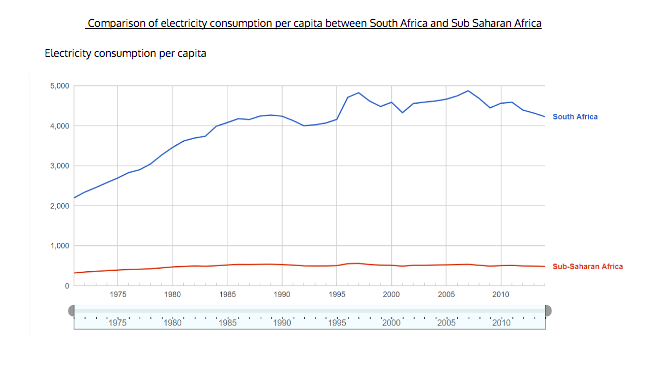
AFRICA • ENERGY & NATURAL RESOURCES
Brandon Curriston
SEPTEMBER 21, 2017
In Africa, providing reliable electricity is one of the continent’s main challenges. Even if energy production could meet the huge demand of its 1.5 billion inhabitants, the energy supply, including infrastructure, remains very poor.
This challenge, unfortunately, does not have a clear and simple solution. It requires creative, innovative, and progressive new ideas and solutions. Luckily, small local businesses understand many of the issues and may hold the key in unlocking viable solutions.
But before we delve into finding solutions, we must begin to understand the severity of the problem.
According to the 2016 World Energy Outlook (WEO), 1.2 billion people, 16% of the global population, live without electricity. And half of that number resides in Africa. What’s even worse, many more people suffer from supply that is of poor quality, as only 10% of Africa is on the grid, with total electrification rate estimated at 45% for the entire continent. Additionally, around 20–30% of African rural income is spent on electricity.

As technological advances continue to push the world forward, and strides are being made in a variety of sectors, one unspoken prerequisite remains the access to electricity. It acts as the springboard for growth. With that said, the amount of talent and resources going untapped by simply the lack of access to electricity is largely unquantifiable.
Traditionally, the main approach to improve access to energy has been to extend the existing grid. However, this further causes greenhouse gas emission, remains very expensive, and is an extremely long process. The generating capacity in Africa only increases by 3% per year, while the network is expanding at a rate of 0.4% per year, and the growth in domestic demand is over 10% per year. Electrifying all of Africa in a centralised way at this rate will take decades, and by the year 2100, hundreds of millions of African people will still be living in the dark.
In this context, the development of innovative business model solutions with low carbon impact adapted to the base of the pyramid should not wait.
Portraying Africa as a single entity remains a dangerous proposition. It implies generalised assumptions for what is in fact a very diverse continent, facing several very unique and challenging circumstances within this macro-ecosystem. Notable is the distinction between North Africa and Sub-Saharan Africa. Unpacking these challenges is vital to thoroughly understand the complexity of the issue at hand and finding viable solutions.

About 50% of the energy produced in Sub-Saharan Africa comes from South Africa, and a large majority of the population has electricity. Nevertheless, 3.4 million households are still not connected to the national grid. They are located mainly in sparsely populated rural areas or in urban “informal settlements.”
South Africa’s energy comes mainly from coal, which provokes combustion wastes, coal mine wastes, and toxic coal land fires.
With the emergence of new business models, there are several coming to the forefront, with their different advantages and limits often determined by regional variables. Micro-mini-grids, solar home systems (SHS), and solar/energy kiosks are emerging models that especially stand out.
Micro-grids are “electricity distribution systems containing loads and distributed energy resources, (such as distributed generators, storage devices, or controllable loads) that can be operated in a controlled, coordinated way either while connected to the main power network or while landed” (CIGRE). They are often used in areas with a lot of inhabitants, not connected to the centralised network.
Solar Home Systems (SHS) are stand-alone photovoltaic systems that offer access to electricity to one house and its inhabitants. In the world, SHS is used by hundreds of thousands of households who are not connected to the grid.
Solar/energy kiosks are essentially stations that sell or lease large batteries used to directly power customer’s products. This model can be very relevant for rural areas where there is no grid. Consequently, being able to take the battery back home is very valuable.
In peri-urban areas with existing or emerging access to the the grid, micro-grids seem to have a bright future. In rural areas, lack of proximity to existing infrastructure necessitates stand-alone solar home systems and solar kiosks. All three models provide much needed resources that address the unique needs of their local populations.
However, the problem of accessing energy is also closely linked with the methods of payment for it. Flexibility in payment model is key to answering customer’s needs, with mobile money being a crucial tool. Additionally, community engagement is essential as young companies experimenting with alternative ways of delivering energy are looking for first adopters, building loyalty, and growing organically. Public support and financing are essential elements for long term success and viability of such a large scale endeavor.
That is why at Seedstars, we are also working very closely with Enel’s renewable energy division, Enel Green Power to source the most innovative business models in the energy sectors and ones that are fostering socio-economic development in rural villages in Africa. As one of our key partners, they are dedicated to providing much needed support to aspiring entrepreneurs and facilitating the growth of external solutions.
Hopefully, continued engagement with both private and public sector will allow the new innovative technology solutions become more wide-spread over time, and shape the future of energy in emerging markets.
*This article is an original piece written for seedstars.com. You can contact the author, Brandon, directly at [email protected] or on Twitter @BCurriston.
“Disclaimer: Seedstars encourages freedom of speech and the expression of diverse views. The views of columnists published on seedstars are therefore their own and do not necessarily represent the views of seedstars.”